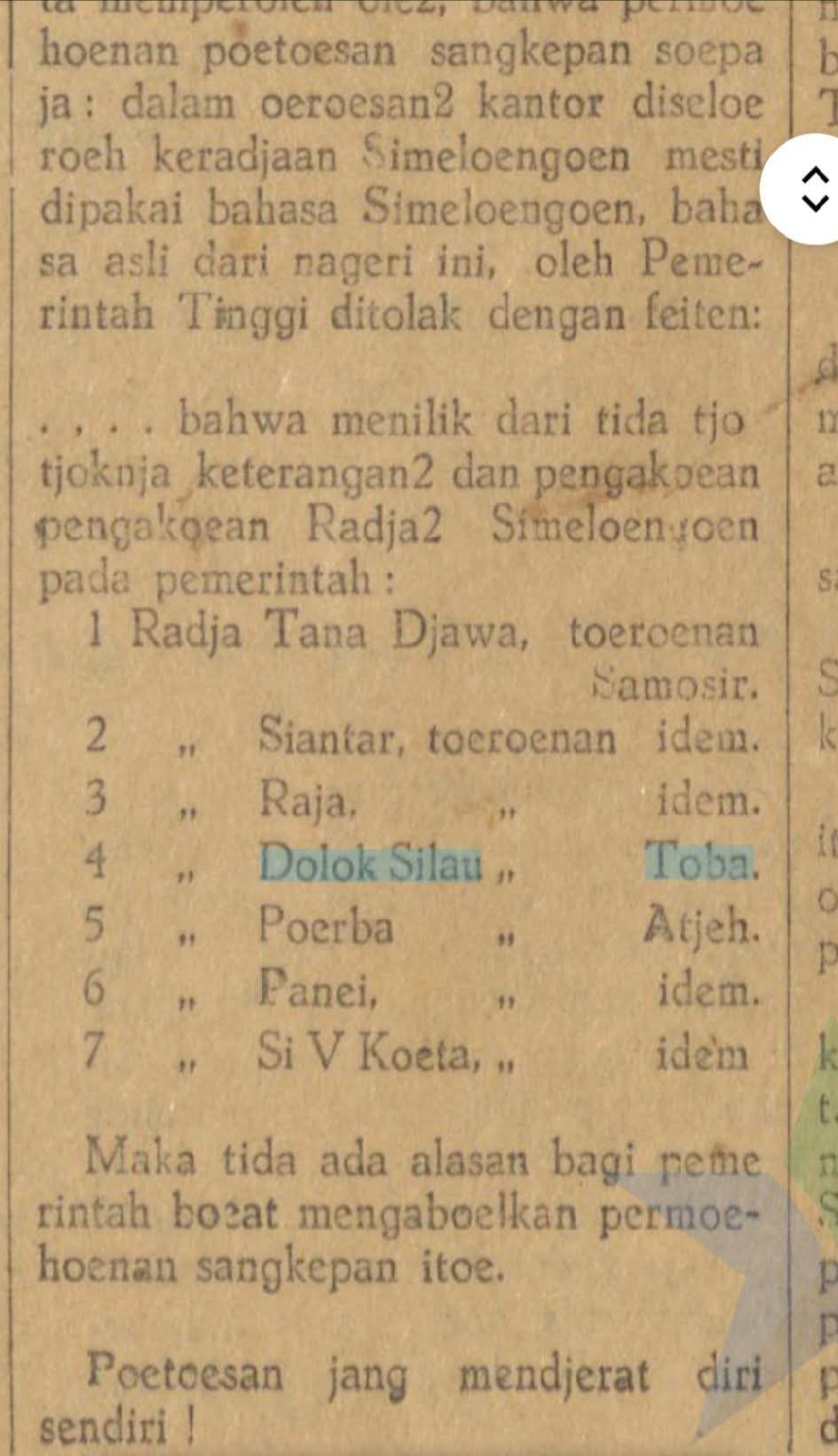A recent intriguing discovery from historical archives has unveiled the lineage of the former rulers in the Simalungun region. A document sourced from the Tjerdas newspaper, Saturday edition of April 10, 1937, provides detailed information regarding the origins of each king who once governed the various territories within Simalungun.
According to the records inscribed on the ancient newspaper pages, the Raja (King) of Tanah Djawa and the Raja of Siantar shared a common ancestral root, tracing back to Samosir Island. This island, situated in the heart of Lake Toba, apparently served as the starting point for the lineage of these two significant kingdoms in Simalungun.
Not only the Rajas of Tanah Djawa and Siantar, but the Raja of Raya was also mentioned to have blood ties with Samosir. This indicates a strong historical connection between the Simalungun region and the center of civilization around Lake Toba in the past.
However, the records concerning the origins of the Simalungun kings were not uniform. The Tjerdas newspaper document specifically stated that the Raja of Dolok Silau had a different lineage, originating from Toba. This information illustrates that not all rulers in Simalungun shared the same ancestral roots.
Furthermore, the newspaper also revealed the origins of three other kingdoms in Simalungun. The Raja of Purba, the Raja of Panei, and the Raja of Silimakuta were identified as having ancestral connections to Aceh. This fact suggests traces of influence or historical relationships between Simalungun and the region at the western tip of Sumatra.
This information regarding the genealogy of the Simalungun kings provides new insights into the formation of power and the potential for inter-regional interactions in North Sumatra in the past. The differences in origin also indicate the diverse backgrounds of the leaders in Simalungun.
The Tjerdas newspaper document containing this valuable information is publicly accessible through the online platform of the National Library of the Republic of Indonesia, Khastara. The digital copy of the Saturday, April 10, 1937 edition can be easily found via the provided link.
In addition, history enthusiasts can also explore the complete collection of the Tjerdas newspaper through the same link. This opens opportunities for further research into various aspects of community life and historical events that occurred in the past.
The disclosure regarding the origins of the Simalungun kings is a significant contribution to the understanding of local history. This information can serve as a foundation for more in-depth research into the cultural, social, and political traces that may have been carried from the ancestral regions of these kings.
With the revelation of this information, it is hoped that it can provide a more comprehensive understanding of the historical roots of Simalungun and the complexity of identity formation in the region. Knowledge about the origins of the past rulers will undoubtedly enrich the historical and cultural treasures of North Sumatra.
This discovery from historical archives illustrates that the history of Simalungun is intertwined with that of other regions in North Sumatra. The ancestral connections of the kings to Samosir and Aceh indicate a past of cultural exchange and political influence.
The Tjerdas newspaper serves as a valuable primary source for understanding the history of Simalungun. The information it provides can spark further research into the social, economic, and political structures within Simalungun during past eras.
This revelation also highlights that the identity of Simalungun is not derived from a single origin. The diverse roots of its kings point to a history of cultural and ethnic diversity shaping the region in earlier times.
Further research into the lineages of the Simalungun kings could uncover additional narratives about the interactions between Simalungun and other regions in North Sumatra.
Understanding these inter-regional relationships can provide a deeper appreciation for the history of this area.
Historical archives, such as the Tjerdas newspaper, are crucial resources for understanding the past. The information they contain can inspire new discussions and research into the history of Simalungun and North Sumatra as a whole.
This discovery can inspire younger generations to appreciate and understand the history of their land. Knowledge of the origins of their former kings can strengthen their identity and sense of pride in Simalungun culture.
The Tjerdas newspaper stands as a silent witness to the history of Simalungun. The information it holds deserves to be preserved and shared with the wider community.
This finding offers hope for uncovering even more historical narratives about Simalungun. Deeper research promises to enrich the historical and cultural heritage of North Sumatra.
Through this discovery, it is anticipated that a more comprehensive understanding of Simalungun's historical roots and the complexities of identity formation in the region will emerge. Knowledge of the origins of the past rulers will undoubtedly enrich the historical and cultural treasures of North Sumatra.




0 comments:
Post a Comment